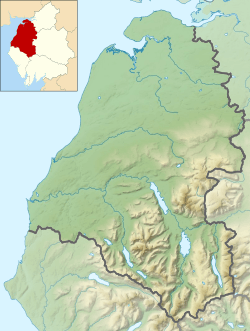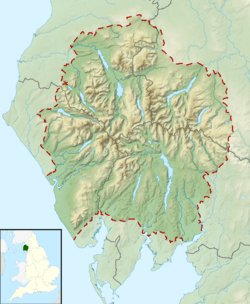Castlerigg stone circle facts for kids

Castlerigg Stone Circle, September 2005
|
|
| Location | Cumbria |
|---|---|
| Coordinates | 54°36′10″N 3°05′54″W / 54.6028366°N 3.098384°W |
| Type | Stone circle |
| History | |
| Periods | Neolithic / Bronze Age |
| Site notes | |
| Ownership | English Heritage |
| Designated | 18 Aug 1882 |
| Reference no. | 1011362 |
The Castlerigg Stone Circle is an amazing ancient monument near Keswick in Cumbria, North West England. It's one of about 1,300 stone circles found in Britain and France.
This special circle was built a very long time ago, between 3,300 and 900 BC. That means it's from the Late Neolithic (New Stone Age) and Early Bronze Age periods.
Many experts say Castlerigg is one of the most beautiful ancient sites in Britain. It sits in a natural bowl surrounded by hills, offering stunning views of some of Cumbria's highest mountains like Helvellyn, Skiddaw, Grasmoor, and Blencathra.
Thousands of visitors come to Castlerigg every year. This makes it the most popular stone circle in Cumbria.
Contents
What is the Castlerigg Stone Circle like?
The stones at Castlerigg are huge boulders. They are made of volcanic rock that was carried here by glaciers long ago. The circle is shaped like a flattened oval. It measures about 32.6 meters (107 feet) at its widest point and 29.5 meters (97 feet) at its narrowest.
The heaviest stone is thought to weigh around 16 tons. The tallest stone stands about 2.3 meters (7.5 feet) high. There's a 3.3-meter (11-foot) wide gap on the north side. This might have been an entrance. Inside the main circle, on the east side, there's a smaller rectangular area made of 10 more stones.
How old is Castlerigg?
Experts believe the circle was built around 3200 BC. This makes it one of the oldest stone circles in Britain, and possibly even in Europe!
Are the stones aligned with the sky?
Yes, some people who study ancient sky patterns (called archaeoastronomers) find Castlerigg very interesting. They've noticed that the sun rises over a hill called Threlkeld Knott during the Autumn equinox (when day and night are equal). Some stones also line up with the midwinter sunrise and certain positions of the moon.
Can you count the stones?
There's a fun tradition that says you can never count the exact number of stones at Castlerigg. Every time you try, you'll get a different answer! This might be because some smaller "packing stones" have appeared over time. These small stones were probably used to support the larger ones when the circle was built. They would have been buried then.
Depending on whether people count these small stones or not, some count 38 stones, while others count 42. The official number, according to the National Trust, is 40 stones.
What about the stone outside the circle?
In the early 1900s, a farmer found and set up a single stone about 90 meters (295 feet) southwest of the main circle. This stone has marks from being hit by a plough, which means it was once buried. We don't know if this stone was originally part of the circle or just a natural boulder.
Why was Castlerigg built?
We don't know for sure why Castlerigg was built or how it was used. However, some experts think it might have been a meeting place. In the Neolithic period, people in the nearby Langdale fells made stone axes. Castlerigg might have been a place where these axes were traded or exchanged.
Stone axes have been found all over Britain, suggesting they were more than just tools. They might have been important for rituals or ceremonies. Perhaps trading axes involved special ceremonies at places like Castlerigg.
How have people studied Castlerigg over time?
Early explorers and writers
Some of Britain's first "antiquarians" (people who studied ancient things) visited Cumbria in the 1600s. They looked at other stone circles but didn't mention Castlerigg. One of these writers, John Aubrey, wrongly thought that stone circles were built by Druids. Druids lived much later, in the Iron Age.
Castlerigg became more widely known in the early 1700s. William Stukeley visited the site in 1725. His notes, published after he died, are the first written record of the stone circle. He described it as "very intire" (meaning complete) and said it had 40 stones. He also mentioned a rectangular area inside the circle with 10 stones, which he thought was a grave.
Stukeley also mentioned seeing another larger circle in the next field. This is a mystery because no one else has ever found evidence of a second circle there!
Castlerigg in the 1800s
In the 1800s, Castlerigg became a popular spot for poets, painters, and writers. Its wild and beautiful setting inspired the Romantic movement. Famous poets like John Keats and Samuel Taylor Coleridge visited the stones. Coleridge described the mountains around it as if they were "attentive to the assembly of white-vested wizards."
An early description of Castlerigg was in an 1843 book by Robert Sears. He quoted another writer, Ann Radcliffe, who called the site "severely grand" and "awful wildness." Sears also noted the rectangular enclosure inside the circle. He wondered if it was a "Holy of Holies" for Druid rituals, a burial place, or both.
In the late 1800s, more detailed research began. C. W. Dymond made the first accurate map of the stones in 1878 and 1881.
First archaeological dig
The only known archaeological dig at Castlerigg happened in 1882. W. K. Dover led this excavation. He dug in the rectangular enclosure inside the circle. He found some small pieces of burned wood or charcoal and some dark soil. Unfortunately, these samples are now lost or too old to be studied with modern science.
Even though it was a small dig, it's important because it's the only one ever done at Castlerigg. Experts believe that more digging might still be possible in the enclosure without harming the site. However, new excavations are unlikely because the site is well-protected and not threatened by farming or building.
What have we learned recently?
Most of what we know about Castlerigg comes from old studies. It's surprising that such an ancient site hasn't had more modern research. None of Cumbria's stone circles have been scientifically dated yet.
Since the 1960s, experts like Aubrey Burl and Alexander Thom have studied stone circles. Burl thinks any patterns or alignments in circles are just by chance. Thom, however, believes the builders were skilled astronomers and mathematicians. He thinks their skills can be seen in all stone circles.
In 1985, English Heritage used special equipment to survey the area around Castlerigg. This was to help them understand the circle better and explain it to visitors. The full results of this survey haven't been published yet.
In 2004, Dr. Margarita Díaz-Andreu from Durham University used lasers to scan the stones. This was to check if there were any ancient rock carvings. Sadly, they only found modern graffiti, not prehistoric art.
Pagan connections
Because Castlerigg has alignments with the sun, it is sometimes used for solstice celebrations by modern pagan groups.
How is Castlerigg protected?
Castlerigg Stone Circle was one of the first sites in Britain to be officially protected by law. It was included in the Ancient Monuments Protection Act of 1882. This meant it became a "scheduled ancient monument."
In 1913, Canon Hardwicke Rawnsley, one of the people who started the National Trust, helped buy the field where the circle stands. He then gave the land to the National Trust. Today, English Heritage is in charge of looking after the stone circle itself, while the National Trust owns the land.
Images for kids
-
The Circle with Blencathra in the background
-
Druidical Circle near Keswick in Cumberland, by F. Grose, 1783
See also
 In Spanish: Círculo de piedras de Castlerigg para niños
In Spanish: Círculo de piedras de Castlerigg para niños









